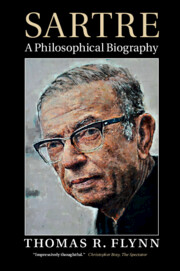Book contents
- Frontmatter
- Dedication
- Contents
- Preface
- Acknowledgments
- Abbreviations
- 1 The childhood of a genius
- 2 An elite education: student, author, soldier, teacher
- 3 Teaching in the lycée, 1931–1939
- 4 First triumph: The Imagination
- 5 Consciousness as imagination
- 6 The necessity of contingency: Nausea
- 7 The war years, 1939–1944
- 8 Bad faith in human life: Being and Nothingness
- 9 Existentialism: the fruit of liberation
- 10 Ends and means: existential ethics
- 11 Means and ends: political existentialism
- 12 A theory of history: Search for a Method
- 13 Individuals and groups: Critique of Dialectical Reason
- 14 A second ethics?
- 15 Existential biography: Flaubert and others
- Conclusion: the Sartrean imaginary, chastened but indomitable
- Select bibliography
- Index
- References
5 - Consciousness as imagination
Published online by Cambridge University Press: 18 December 2014
- Frontmatter
- Dedication
- Contents
- Preface
- Acknowledgments
- Abbreviations
- 1 The childhood of a genius
- 2 An elite education: student, author, soldier, teacher
- 3 Teaching in the lycée, 1931–1939
- 4 First triumph: The Imagination
- 5 Consciousness as imagination
- 6 The necessity of contingency: Nausea
- 7 The war years, 1939–1944
- 8 Bad faith in human life: Being and Nothingness
- 9 Existentialism: the fruit of liberation
- 10 Ends and means: existential ethics
- 11 Means and ends: political existentialism
- 12 A theory of history: Search for a Method
- 13 Individuals and groups: Critique of Dialectical Reason
- 14 A second ethics?
- 15 Existential biography: Flaubert and others
- Conclusion: the Sartrean imaginary, chastened but indomitable
- Select bibliography
- Index
- References
Summary
The Imaginary
In many respects this book summarizes and expands the arguments and applications of the previous two. As such, it is the apex of Sartre’s phenomenological psychology. If one excludes his increasingly extended studies in “existential psychoanalysis,” never again will he treat a major issue in psychology at such length or in such depth. In the “Philosophical Introduction” to his excellent translation of L’Imaginaire, Jonathan Webber judges it “the most sustained and detailed account of the nature of imagination in Western philosophical literature.” In view of Sartre’s attention to imaging consciousness heretofore, it can be read as a compendium of his early philosophy and a gateway to the properly “ontological” phase of his concerns in Being and Nothingness. He alludes to that “existential” opening when he claims that “imagination is … the whole of consciousness as it realizes its freedom” (Ire 186). In this sense, it also previews his multivolume study of Flaubert’s life and time, which he once described as its sequel.
As we suggested above, Sartre divides parts one and two of his work into the “Certain” and the “Probable,” according to the Husserlian differentiation between the data of reflection that are grasped immediately at the end of an eidetic reduction, in this case the “essential structure” of the image, and the probable conclusions hypothesized on the basis of inductive claims about that essential structure. He will then address our understanding of the “psychic life” and our imaginary life in terms of this structure and these probabilities. Sartre’s concluding observations about the role of imaging consciousness in the aesthetic realm serve to synthesize his ongoing interest in the imaginary and the conceptual in our aesthetic consciousness of the work of art.
- Type
- Chapter
- Information
- SartreA Philosophical Biography, pp. 104 - 136Publisher: Cambridge University PressPrint publication year: 2014



